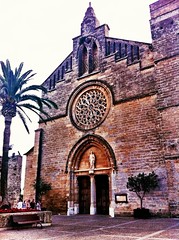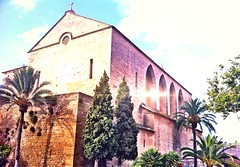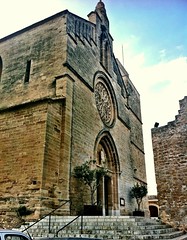Church of Sant Jaume
In 1248, Pope Innocvent IV mentions the Alcudian Church in the list of Majorcan Churches. The original church was begun in the time of King James II, towards the year 1302; it is stated that in the year 1340, worship was already celebrated there. The prescarious state of this temple and the abundant raining caused its collapse in the year 1870.
The building work of the news church –neo gothic- began in the year 1882, thanks to the efforts of the Parish priest Ferragut, as well as the Local Consistory. It took them 12 years and it was blessed by the Majorcan Bishop J.M. Cervera, on July 25th, 1893.
It is a building of only one nave of 37 x 12 metres, covered by ribbed vaults. The vault has got five circular keystones decorated with vegetal motifs, and in one of them –located in the presbytery- there is the anagram of Jesus. The natural lighting is obtained through thirteen picture windows and a big rose window sculpted by the Alcudian artist Llorenç Ferrer Martí.
The front is austere. It’s formed with a pointed arch with the image of Saint James –work of Menígia Caubet- inside the tympanum. In the second section there is the rose window, above it there is a bricked up picture window flanked by six windows. The front is austere. It is formed with a pointed arch with the image of Saint James-work of Remigia Caubet- inside the tympanum. In the second section there is the rose window.
Left Side Chapels:
Saint Sebastian chapel. There is an image of Saint Sebastian, work of Llorenc Ferrer. In the past, in this chapel there was the baptismal font.
Chapel of Our Lady of Carmen. There is a neo-gothic altarpiece which represents the mysteries of the Rosary and the image of Our Lady, work of the sculptor Llorenc Ferrer.
Saint Joseph Chapel. Saint Joseph flanked by Saint Isidore and Saint Isiore and Saint Anthony the Abbot. It is work of Miquel Arcas in 1927.
Holly Heart of Jesus Chapel. On the left side there is the image of Saint Gemma Galgani and on the right side there is the image of Saint Anthony of Padua. It is work of Miquel Arcas in 1919.
Baptism Chapel. It was moved in 1989. There is a picture of Saint John the Baptist.
Right Side Chapels
The immaculate Conception of the Virgin Mary. There is an altarpiece, work of Miquel Arcas and the gilding is work of Llorenc Ferrer. The present image was blessed in 1926. The picture windows of the right side represent Saint Rose and Saint Francis of Assisi. On the left, there is the image of Saint Catherine and the Archangel Saint Ralph.
Lateral Portal with a surbased arch. Inside it, there is a picture of the Mary’s Nativity, a passage of the altarpiece of Our Lady of the Rosary and a picture of Saint Cecilia. Above the Portal there is a polychromed rose window, work of Llorenc Ferrer. At the top floor there is the organ, work of Josep Barcelo in Runggaldier, 1893; the organist Pere Reynes made a huge improvement in 1987.
Marble Stone Plaque. It describes the rebuilding of the church.
Presbytery. There is a neo-gothic altarpiece with the image of Saint James in the centre of it and Saint Peter and Saint Paul at each side. It is work of Llorenc Ferrer and Miquel Arcas. At the bottom of the altarpiece, there is a bas-relief of biblical scenes, the four evangelists, the martyrdrom of Saint Peter and Pail, Jesus giving Saint Peter the church keys or the arrival of the Appearance of Santiago. At the centre, there are eight boxes which represent Saint Catherine Thomas, the resurrection of Kesus, the holy family’s flight to Egypt, the blessed Ramon Llull, the temptations of Jesus, Jesus knocking on the door, the Good Minister and the Garden Prayer.
The two pulpits of the presbytery are sculptured with evangelical motifs: the Appearance of Jesus to the Disciples and image of the Good Minister.

|

|

|
The table of the of the Altar is an only piece of stone from Binissalem.
The Choir. It is located at the opposite side of the presbytery, and above the entrance. The lower side is decorated with the coat of arms of the Ferragut family, remembering the parish priest (1858-1898), the architect of the rebuilding of the Temple. Next to the Choir Portal, there is the little chapel of Our Lady of the Victory. In each side, there are fourteen pottery pictures which represent the Way of the Cross, work of the Alcudian Rafel Bordoy.
The Bell Tower has a square floor. Its construction started under the command of the bishop Arnedo in 1568 and finished in 1704. However, it seems unfinished. Nowadays, it has four bells. Moreover, it has the most ancient bell of Majorca from the year 1309.
Saint Christ Chapel. It was built between the years 1678 and 1697 to honour the image of Saint Christ. It is baroque style and is formed with only one nave of four stretches covered with ribbed vaults and with a dome with a crossing tower.
A polychromed wood carving from the 15th century dominates the Altar. It represents the Saint Christ, the venerated image which sweated water and blood (1507) and is taken out in procession every three years. It is a part of the Saint Christ baroque altarpiece, which was made in 1718 by the sculptor Mateu Juan i Serra. It is a niche altarpiece with only one section with three panels, a predella and an attic, including relieves and pictures. The central panel is bigger than the literal panels. The predella is made up of the tabernacle, in the centre, flanked by some pictures which represent the Birth of Jesus and the Adoration of the Magi. In the cenral panel there is the image of Saint Christ and the pictures of Saint Matthias on the left and Saint Steve on the right. Two allegory sculptures are located on the ends. The faith on the left and the Hope on the right. This panel ends with the city coat of arms. The Baptism of Jesus is represented in the attic and around it there are some kneeled angels and on the ends, there are allegory representations of the Charity (On the left) and the Good Acts (on the right). A big golden sun covered with a crown held by two angels ends the altarpiece.
On the right of this altarpiece, there is the Our Lady of Pain altarpiece, which comes from the disappeared Franciscan convent of Alcudia (1853). In the centre, there are the scene of the Falling Away, Our Lady of Pain who carries the seven pain swords flanked by the pictures of Saint Paul Apostle (on the left) and Saint Paul the Hermit (on the right). In the predella there are the image of the Death of Saint Johnm the Falling Away with the three Marys and the worship of a Franciscan service. In the attic, there are the image of the Holy Ghost giving the Good News to the archangel Saint Gabriel, the image of Saint John fighting and an image of the Vigin Mary.
On the left of the chapel, there is the picture of Saint Lawrence Martyr and on the right, the picture of Saint Joseph and the child. In the predella there are some scenes from the martyrdom.
In the parish museum there are liturgical objects, fragments of pictures and carvings from the ancient church. In the showcases, there are robe of Our Lady of the Victory and Saint Christ from Alcudia, a collection of holy glass, a chalice from the 14th century and the ancient Saint Anna altarpiece from the 15th Century.



No Comments